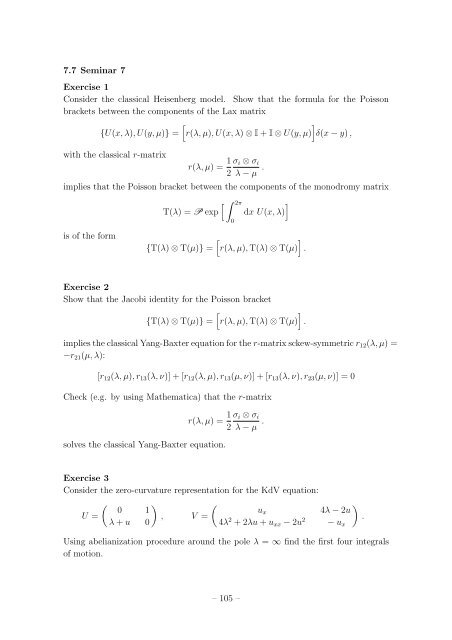Student Seminar: Classical and Quantum Integrable Systems
Student Seminar: Classical and Quantum Integrable Systems
Student Seminar: Classical and Quantum Integrable Systems
Create successful ePaper yourself
Turn your PDF publications into a flip-book with our unique Google optimized e-Paper software.
7.7 <strong>Seminar</strong> 7<br />
Exercise 1<br />
Consider the classical Heisenberg model. Show that the formula for the Poisson<br />
brackets between the components of the Lax matrix<br />
[<br />
]<br />
{U(x, λ), U(y, µ)} = r(λ, µ), U(x, λ) ⊗ I + I ⊗ U(y, µ) δ(x − y) ,<br />
with the classical r-matrix<br />
r(λ, µ) = 1 σ i ⊗ σ i<br />
2 λ − µ .<br />
implies that the Poisson bracket between the components of the monodromy matrix<br />
is of the form<br />
[ ∫ 2π ]<br />
T(λ) = P exp dx U(x, λ)<br />
0<br />
{T(λ) ⊗ T(µ)} =<br />
[<br />
]<br />
r(λ, µ), T(λ) ⊗ T(µ) .<br />
Exercise 2<br />
Show that the Jacobi identity for the Poisson bracket<br />
[<br />
]<br />
{T(λ) ⊗ T(µ)} = r(λ, µ), T(λ) ⊗ T(µ) .<br />
implies the classical Yang-Baxter equation for the r-matrix sckew-symmetric r 12 (λ, µ) =<br />
−r 21 (µ, λ):<br />
[r 12 (λ, µ), r 13 (λ, ν)] + [r 12 (λ, µ), r 13 (µ, ν)] + [r 13 (λ, ν), r 23 (µ, ν)] = 0<br />
Check (e.g. by using Mathematica) that the r-matrix<br />
solves the classical Yang-Baxter equation.<br />
r(λ, µ) = 1 σ i ⊗ σ i<br />
2 λ − µ .<br />
Exercise 3<br />
Consider the zero-curvature representation for the KdV equation:<br />
( )<br />
(<br />
)<br />
0 1<br />
u<br />
U =<br />
, V =<br />
x<br />
4λ − 2u<br />
λ + u 0<br />
4λ 2 + 2λu + u xx − 2u 2 − u x<br />
Using abelianization procedure around the pole λ = ∞ find the first four integrals<br />
of motion.<br />
.<br />
– 105 –

















